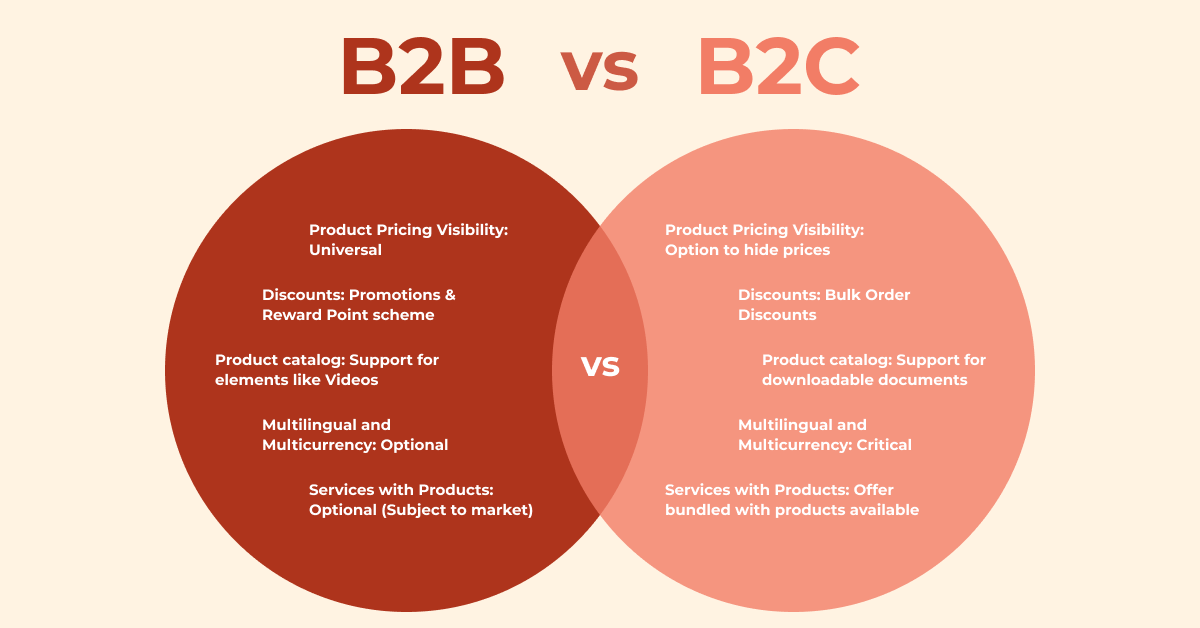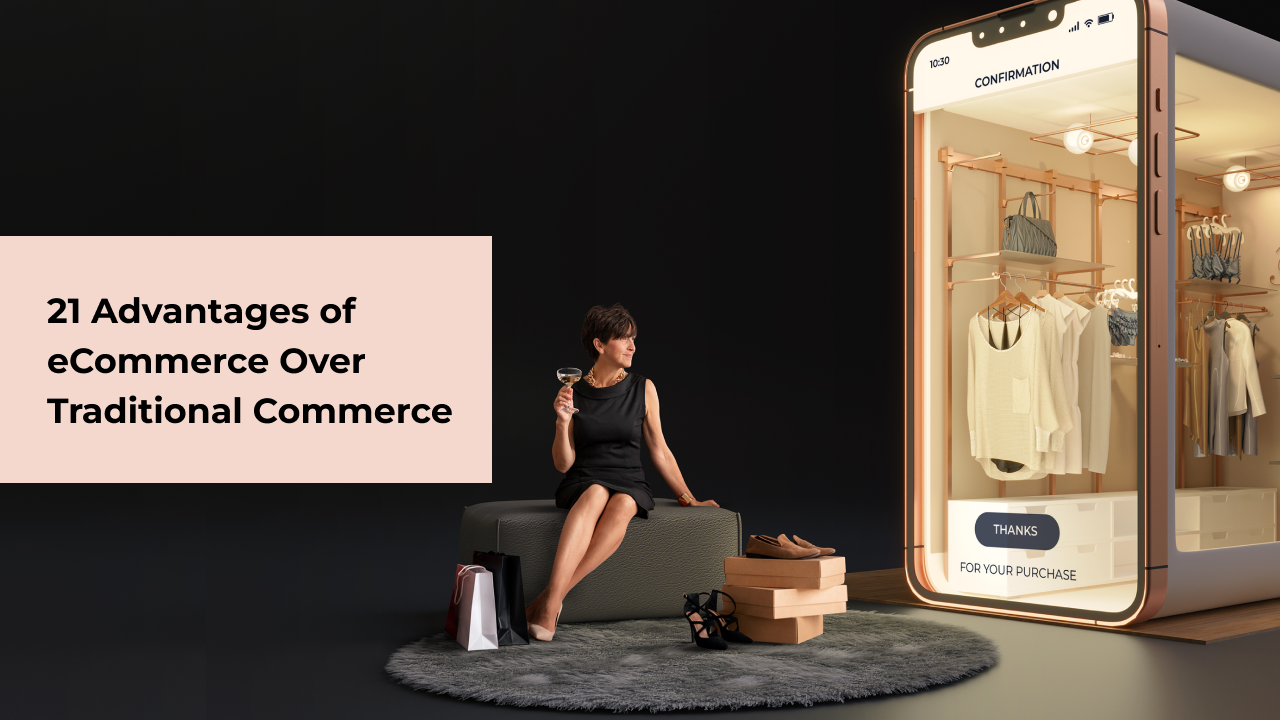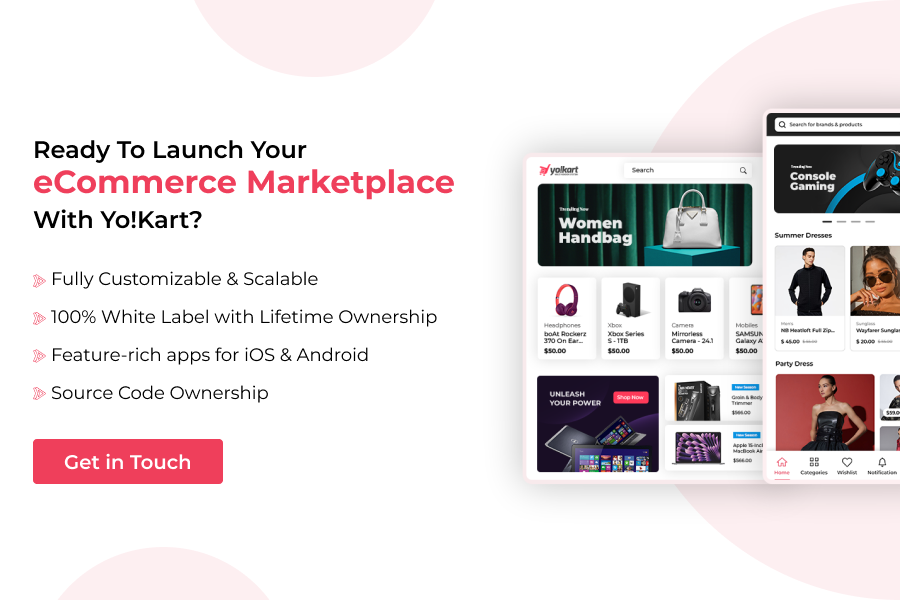Last Updated: 31st January, 2025
If you were to ask buyers, the end consumers, what made them commit to a purchase? The response could be beyond just the value addition of the product to their life. Things like: I like to buy from this brand; or This makes me feel good, Oh, My friend has it too! will start to take center stage, at times more than the product itself.
But if you post the same question to a business, the priorities will shift to ROI, brand image, long-term business prospects, traction with consumers, product value for the consumers and more.
There is a considerable difference in how buying triggers work for end consumers and businesses. Likewise, the whole purchase journey differs for both sets of buyers. While sellers in the physical world have a broader range of variables to address this difference, including human interactions. The digital space interacts via the device itself. Here, the controllable variables are the platform features and UI/UX. These variables team up to offer buyers the shopping experience they are looking for.
Since expectations and the buying journey of buyers, in the case of B2B or B2C business interactions vary, these variables need to vary as well. In this blog, let’s explore the difference between B2B and B2C eCommerce platforms – that allow buyers and sellers in both domains to interact and transact in a purpose-driven ecosystem, tailored to their needs.
B2B or B2C: 6 Things to Consider Before Choosing Your Platform
As humans, all our actions stem from perceived desires. According to eminent American psychologist Abraham Maslow, human needs can be classified into self-actualization, esteem, belongingness, safety, and physiology. Indeed, in the case of B2C, these are the key drivers behind our purchase decisions as consumers.
On the contrary, for B2B, the drivers are business goals’ driven. This difference in priorities between buyers in each case leads to distinct processes. Discussed below are the key differences between these processes that eCommerce platforms need to consider.
1. Buyers’ Profile: Differences in the B2B and B2C Buying Process
While it is easier to define the buyer in B2C interactions, B2B is complex and business interactions can be between two businesses anywhere across the value chain of a product. For instance, consider a scenario where a product reseller (like retailers), interacts with wholesalers, or in the case wherein a business procures a product for internal consumption. While both are B2B interactions, they will have different variables at play. This is also one of the reasons why B2B eCommerce platforms have to be more dynamic than B2C – and they have to incorporate varying requirements.
2. Sales: The Intent of a Buyer in B2B and B2C Before Making Purchase Decisions
Since the priorities of buyers in both domains differ, their approach to sales varies significantly as well. Take the example of a fashion accessory like a luxury watch. Consumers will consider buying it for themselves or as a gift. For the buyer, this might be the only luxury watch they buy from the seller. However, businesses that buy the same product to be sold to the end buyer – may need to offer the product for a longer period, till it has sustainable buyer traction.
In most B2C instances, consumers will be the only decision-makers in the purchase. The product and the brand will matter more than the sellers. And in most scenarios, the consumer journey will be short. In B2C, businesses also have the opportunity to understand impulse sales psychology and leverage their platform to trigger such buying behavior.
On the other hand, the sales cycle in B2B is longer. Here, business relations can play a key role in the sales process, especially if the buyers are considering reselling the procured products. In B2B, the decision makers can be more than one, and the sales cycle tends to be longer.
3. Transactions (Value and Terms): Flexibility in Payments in B2B and B2C
Let’s consider the same example of the luxury watch. Consumers are unlikely to buy the product beyond a few numbers. Businesses, however, need to go for a higher number.
Transactions in B2C are low volume and lesser value. On the contrary, B2B transactions are higher in volume. Also, B2B transactions are cyclic, which means a manufacturer or a distributor may accept orders beyond their real-time inventory stocks.
Moreover, consider the case where a business procures custom-built machinery or a bespoke software solution. In such scenarios, the business deal can include long-term commitments, from the buyers and sellers. So the transaction terms need to be more flexible and may involve dynamic payment options.
4. Product Pricing: A Strategic Approach to Drive More Sales in B2B and B2C
For vendors selling to consumers, the prices of the products are subject to the business strategy of the business and not the consumers themselves. Barring exceptions like auctions, prices of the products can be universally visible to all. Any discounts or marketing promotions applicable can also be displayed alongside.
But business deals between businesses themselves work differently. They can be subject to order volume, payment terms, the location of the buyers, aspirations for market penetration, inventory stocks, and/or other complexities that come with B2B. Hence vendors in the domain would want more flexibility to implement their pricing strategy.
Build a platform giving your B2B vendors complete flexibility
5. Marketing and Research: Know Your Target Audiences in B2B and B2C
Another outcome of the varying priorities of buyers in both domains is how sellers reach out to their target audience. In B2C, the marketing is more experience-driven, aligned with the aspirations of the consumers. While in B2B, the buyers need more information and value-driven details. They want to evaluate the product from a business sense perspective. Hence, buyers in both domains have a varying approach to research.
6. Services and Products: Aiding Customers by Offering the Best
While this difference is more subject to the niche of the business. Still, B2C deals are focused on either services or products. Vendors have the capability to operate exclusively in either of the two scenarios, as end consumers may not want both under one roof.
However, in B2B – the services gain more significance. These services may be related to the product itself. For instance, a business may consider procuring T-shirts from one vendor and T-shirt printing services from another. Another example can be a business procuring products that need regular maintenance from authorized personnel. They will need such services from a single source.
Difference in B2B and B2C eCommerce Platforms
The differences between buyers in B2C and B2B emphasize a key imperative ― there can’t be a one-size-fits-all solution. Especially in an age where eCommerce has matured (and is further evolving) to give buyers tailored personalized experiences – buyers in both domains need an ecosystem that is suited to their priorities.
So the question now worth pondering over is – How do you address these varying priorities with your eCommerce platform?
The answer lies in understanding these differences and offering an exclusive ecosystem that suits the needs of the specific user type. Let’s have a look at the difference in features of a B2C and a B2B eCommerce platform.
| Variation Addressed | Parameter | B2C Platform |
B2B Platform |
| Pricing Strategy/Sales |
Product Pricing | Fixed | Flexible based on quantity/or Request For Quote |
| Product Pricing Visibility | Universal | Option to hide prices | |
| Sales/Transactions | Discounts | Promotions & Reward Point scheme | Bulk Order Discounts |
| Payment Terms | Fixed with eWallets and Cash On Delivery option | Flexible with Part Payment option (Credit Line) |
|
| Minimum Order Quantity | Optional | Required | |
| Custom Invoicing | Not Required | Required | |
| Marketing & Research |
UI/UX | Engaging, Marketing oriented | Clean UI, detail & information-driven |
| Product catalog | Support for elements like Videos | Support for downloadable documents | |
| Product reviews | Parameters based | Information based | |
| Search | Elastic with keyword search | Advanced with keyword search | |
| Shop/Product Tags | Required | Not Required | |
| Operations (Difference in Buyers profiles) |
Shipping | Low cost options are pivotal, in-house, etc. | Low cost options are critical, vendors’ in-house, etc. |
| Returns | Critical | Subject to market | |
| Multilingual and Multicurrency | Optional | Critical | |
| Services with Products |
– | Optional (Subject to market) | Offer bundled with products/exclusive/available at checkout |
If you’ve analyzed here keenly we have discussed some platform features/modules in this blog. The reason for this is despite their differences, the underlying principles in both B2C and B2B remain the same. eCommerce as a whole has some fundamental underpinnings that are common to users of both domains.
Engage your users with pivotal and proven features
Top 10 B2C eCommerce marketplaces Leading in the Industry
Entrepreneurs and business owners looking to launch an online B2C marketplace should once glance at these popular B2C platforms in the industry. These marketplaces are inspirations for many startups and businesses. Here is the list of the top ten B2C (Business-to-Customer) marketplaces that can help you understand your goal better.
Popular B2C eCommerce Platforms
- Amazon
- eBay
- Walmart
- Shopee
- Rakuten
- Etsy
- Tmall
- Newegg
- Target
- Flipkart
1. Amazon
Amazon is not just an online marketplace but it’s a dream of many entrepreneurs and business owners who want to launch an online platform. The platform has become an essential part of our lives that helps us meet everyday needs. Amazon almost tackles all industries to offer a complete shopping solution to its customers.
The mind behind this most accepted online B2C eCommerce platform was Jeff Bezos Who launched the marketplace in November 2000. The reason behind the initiative was to provide a platform for the merchants where they could list and sell their products directly to global customers. Today, the platform has more than 310 million active users worldwide which is truly a large number.
2. eBay
eBay, one of the most trusted online platforms, is typically famous for retail sales. However, if you are a business and want to trade on eBay, the platform provides opportunities for businesses too. The platform operates in more than 200 countries and the platform has a wide collection of almost two billion products that makes it one of the most preferred choices among businesses and customers.
3. Walmart
Walmart is one of the largest eCommerce platforms that allows businesses to sell products to customers. It sells a wide range of products from multiple categories such as clothing, electronics, groceries, home decor items and many more. In addition, the massive customer base of the platform helps sellers expand their reach in order to generate more revenue through diverse offerings.
4. Shopee
Shopee was founded in 2015 in Singapore. However, Shopee expanded its reach to most of the regions of Southeast Asia and Taiwan. It is one of the popular eCommerce platforms in Southeast Asia and Taiwan. With a total gross merchandise volume of $47.9 billion which was nearly half of the total GMV of the Southeast Asian Market, the platform became the largest marketplace in the region. Shopee allows its users to buy or sell a variety of products including electronics, clothing, groceries and more.
5. Rakuten
Rakuten is a merchant-focused marketplace that offers an extensive range of products including electronics, fashion and more. The platform offers complete control to the merchants by allowing them to control their storefronts, product pages and overall customer experiences. This Japan-based eCommerce platform was founded in 1997 by Hiroshi Mikitani and currently operates in 30 different countries and regions.
6. Etsy
Founded in the year 2005 in Brooklyn, New York, the platform gained popularity for offering unique, handmade and vintage items on an online platform which were not readily available on other online platforms. Etsy also opened up opportunities for artists, creators and crafters to sell their products directly to customers. This direct approach to connecting creators with customers fostered a stronger relationship and sense of community. In addition, the user-friendliness of the platform also helped in gaining reach and customer base.
7. Tmall
Tmall is another popular online B2C marketplace, operated by Alibaba Group, the largest marketplace platform in China. Tmall allows businesses to sell a variety of products to its customers. However, the platform has its own dedicated “Tmall Global” to conduct cross-border eCommerce transactions. It allows vendors overseas to sell their products to Chinese customers through the platform.
8. Newegg
Popularly considered a B2C marketplace and known for selling electronic items, computer hardware and other tech-related products. With the way the gaming industry is growing, Newegg is the favorite destination for gamers and tech enthusiasts. In the fiscal year 2023, the platform’s gross profit was $167.6 million. However, it was down from 2022, $216.7.
9. Target
Target is a global marketplace that enables shoppers from more than 200 countries and territories access exceptional products. It helps buyers to get quality products from trusted brands around the world. According to Digital Commerce 360, Target is ranked as fifth online retailer of North America by web sales. Reports say that Target’s net sales were $106 billion in 2023. Now, the platform is in the list of popular retail giants including Walmart, Costco, Dollar General, and more.
10. Flipkart
Flipkart is another popular eCommerce platform, primarily focused in India. However, the company has also partnered with eBay to tackle global markets. The platform is often compared with Amazon in India. According to various resources, Flipkart is more popular in India than Amazon, holding 48% market share in the Indian online retail sector where Amazon holds around 32%. Flipkart’s total revenue in 2024 was $8.2 billion and net income was $490 million. However, Flipkart’s 77% stake was acquired by Walmart in 2018 for $16 billion, the largest deal at that time. Today, Walmart owns 80.5% of Flipkart.
Launch B2C Marketplace like eBay, Etsy and Walmart
Top Ten B2B eCommerce Platforms Transforming B2B Trade Worldwide
In today’s eCommerce universe manufacturers, suppliers, wholesalers and retailers have the opportunity to reach wider businesses through popular B2B online marketplaces. Businesses are growing faster than ever before due to digital transformations and advancements in technology. Explore the list of popular B2B marketplaces empowering businesses worldwide:
Popular B2B eCommerce Platforms
- eWorldTrade
- Alibaba
- Amazon Business
- AliExpress
- Global Sources
- Made-In-China
- DHGate
- Tradewheel.com
- ECplaza
- Faire
1. eWorldTrade
eWorldTrade is one of the largest eCommerce platforms that connects all sizes of businesses allowing them to trade online. The platform has opened up an option for businesses to trade globally by breaking all the boundaries. In addition, eWorldTrade is also famous for its user-friendly interface, advanced SEO and marketing tools, and flexible payment options.
2. Alibaba
Alibaba is another giant in the B2B eCommerce landscape. It connects and allows businesses across the world to buy or sell anything they want to sell or buy on the platform. The massive categories and ranges of products help Alibaba stand out from the competition.
3. Amazon Business
In the eCommerce space, who doesn’t know the name of Amazon? Amazon Business is a B2B eCommerce platform that helps businesses trade online. The platform has a variety of tools and features that let businesses manage their procurement and purchasing effortlessly.
4. AliExpress
A subsidiary of Alibaba Group, AliExpress today is an international online retail platform known for offering products at competitive prices across 230 different countries. However, this eCommerce platform not only serves B2B businesses but is also accepted by B2C customers due to its cost-effective product offerings.
5. Global Sources
With a base of 10 million regular buyers on the platform from 250 countries, Global Sources is another well-known B2B marketplace platform. This leading multi channel B2B online marketplace has verified suppliers from various industries offering authentic B2B trades on the platform.
6. Made-In-China
Made-in-China is a global B2B marketplace that connects businesses worldwide with Chinese manufacturers, wholesalers, exporters and suppliers. Fostering global commerce, the platform bridges the gap between international businesses and Chinese businesses by connecting them online. The platform has a wide range of product categories available with good margins.
7. DHGate
DHgate is also a B2B platform that allows small and medium-sized businesses to trade online. The platform has thousands of active merchants and more than 30 million listed products tackling various industries. The platform offers several payment options to its users making shopping a hassle-free experience. In addition, DHgate’s real-time tracking, and easy return and refund policy also make it an ideal platform for businesses.
8. Tradewheel.com
Headquartered in the US, Tradewheel is a recognized B2B marketplace that provides a safe platform for businesses worldwide to trade online. The company operates in more than 195 markets with millions of listed products. Tradewheel also facilitates business with a dedicated ISM (Independent Account Manager) to ensure smooth business transactions.
9. ECplaza
ECPlaza is a leading B2B eCommerce platform that connects buyers with manufacturers, suppliers, and exporters worldwide. With more than 10 million registered members in more than 150 countries, the platform has gained enough popularity. ECplaza offers products from multiple categories including automobiles, chemicals, electronics, machinery, hardware and healthcare products.
10. Faire
Founded in 2017, Faire is an online wholesale marketplace. It connects independent retailers with small businesses such as artisans, manufacturers, designers and emerging brands. The platform uses a machine learning algorithm to match local retailers with brands and products that perfectly align with their stores. With a mission to empower local businesses, Faire enables access to a global platform to sell products worldwide.
Build a Feature-rich B2B Marketplace Platform
Readymade Solutions to Launch Your B2C/B2B eCommerce Platform
To make your entrepreneurial journey even more convenient, you can use readymade solutions that are purpose-built to meet the needs of each user type.
YoKart and YoKart B2B are solutions built for each of these specific needs. While YoKart caters to the needs of users in the B2C domain, YoKart B2B provides an apt platform for B2B users. For instance, YoKart B2B offers features like RFQ, bulk order discounts, MOQ, part payments, custom invoicing, and support for services & products, right out of the box. Likewise, YoKart is a solution tailor-made for an intuitive and memorable shopping experience for consumers of today.
Both solutions come with a host of pre-integrations and are offered with one-time payment options. The best way to understand the working is to go through the demos of both YoKart and YoKart B2B.
B2C Marketplaces Launched by Yo!Kart
- Voyij
- GNPK Marketplace
- RxAll Delivered
- Mastang
- TransporTECO
B2B Marketplaces Launched by Yo!Kart
- Uni Diamond
- Bozinga
- CX Marketplace
- Green Sourcing Hub
- Rexporta
Final Thought
A key to winning in eCommerce is reaching out to the target audience with what they need. If you can solve key pain points of the users, you have their attention. In a multi-vendor eCommerce marketplace, these users are both sellers and buyers. Your business will be giving them a platform to conveniently carry out their activities. Moreover, with eCommerce reaching the level of maturity that it has, your users already have certain minimum requirements, when it comes to expectations.
Hence, it is essential that you consider offering the right set of features, tailored to each user type. By the information in this blog, you can get an understanding of how your eCommerce platform can meet their specific needs.
FAQs
Q 1. Which is the most common type of marketplace B2B or B2C?
Ans. B2C (Business-to-Customer) marketplaces are common compared to B2B (Business-to-Business) marketplaces.
However, there are a few more marketplaces types including C2C (Customer-to-Customer), D2C (Direct-to-Customer) and more.
Q 2. Can I launch a scalable eCommerce platform with Yo!kart?
Ans. Yes, Yo!Kart is a fully customizable and scalable eCommerce platform that allows entrepreneurs and business owners to launch a fully scalable online platform.
In addition, Yo!Kart also provides source code ownership that allows complete access to the source code of the platform. Another advantage that can be helpful in scaling the platform.
Q 3. How can I tailor my marketplace according to my brand?
Ans. You can launch a tailored marketplace platform aligning it with your marketplace requirements with Yo!Kart. Yo!kart is a readymade marketplace platform that allows you to build and customize your platform with your brand. In addition, Yo!Kart’s custom development services also help you meet your specific marketplace needs.
Q 4. Can I build a global marketplace to target global audience with Yo!Kart?Ans. Yes, with Yo!Kart you can launch a global marketplace. Yo!Kart has empowered thousands of global marketplaces. Also, Yo!Kart’s multi-lingual and Multi-currency support makes it a reliable choice for global eCommerce platform. If you want to launch your platform to target a global audience, Yo!Kart can be a powerful solution.




